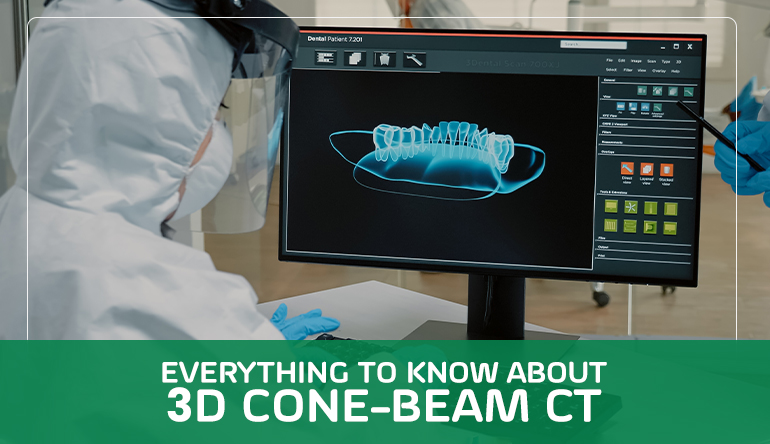3D Cone-beam CT is one of the advanced procedures that have upgraded the standards of the medical world. If you have heard the term from your doctor, the odds are that you might be undergoing a 3D Cone-beam CT. However, before undergoing any medical procedure, you should first know the procedure, its benefits, side effects, and other essential things about it.
Although your doctor will explain the process to you, it is better to do some research yourself. In this blog, we will walk you through the process of 3D Cone-beam CT and explain all the essential details about it. But first, let’s take a deep dive into 3D Cone-beam CT.
Read More: WHAT ARE IMPACTED WISDOM TEETH?
What is 3D Cone-beam CT?
A 3D Cone-beam computed tomography, also called CBCT, is a unique X-ray technique used to generate three-dimensional cross-sectional images of the inside of your teeth. Computed tomography scans, or CT scans, have been used for a long time. With the combination of X-rays and high-tech computers, medical professionals can generate images of the inside organs. In this way, they are able to view the interior of organs without cutting them.
3D Cone-beam CT is one type of CT scan that has benefited dentists and people facing dental problems. CBCT has many uses, including root canal diagnosis, detection of abnormal teeth, tooth decay, and other dental problems.
Computer technology generates a three-dimensional image of the teeth. Doctors use the information generated from a CBCT to analyze your oral health and diagnose dental problems. Images generated from a cone beam CT are used for a detailed observation of the teeth and to perform accurate treatments.
Procedure for CBCT
3D Cone-beam CT is a very quick and easy process performed in less than a minute. A cone-beam CT machine is used to generate a complete radiograph of the teeth. Before the procedure starts, you will be asked to take any jewelry or metal objects you are wearing. You may already know these steps if you have had an X-ray or a CT scan.
Depending on the scanning equipment used, you’ll be asked to lie down or sit on a chair. You’ll have to remain still when the scanner revolves around you. CBCT is a painless process, and you’ll be able to return to your normal activities right after the procedure. Your doctor will analyze the final images generated by the computer and discuss the results with you.
Difference Between Dental Cone-beam CT and Conventional Procedures
Before 3D Cone-beam CT was introduced to the dental world, conventional procedures like X-rays and ordinary CT scans were used to analyze oral health. CBCT generates images like conventional CT; however, CBCT is much easier and less expensive than CT. In addition, the equipment used for cone-beam CT is easier to use and much smaller than CT machines.
Compared to dental X-ray images, CBCT-generated images are very high quality and give a detailed view of the interior of teeth, including soft tissues, nerves, and dental structures. In addition, it produces less radiation than dental X-rays and more accurate and high-resolution images.
Are you looking for dental services in Faisalabad? Get 3D Cone-Beam CT and other treatments from highly qualified doctors at Ruhaan Diagnostic Center at The Professionals.

